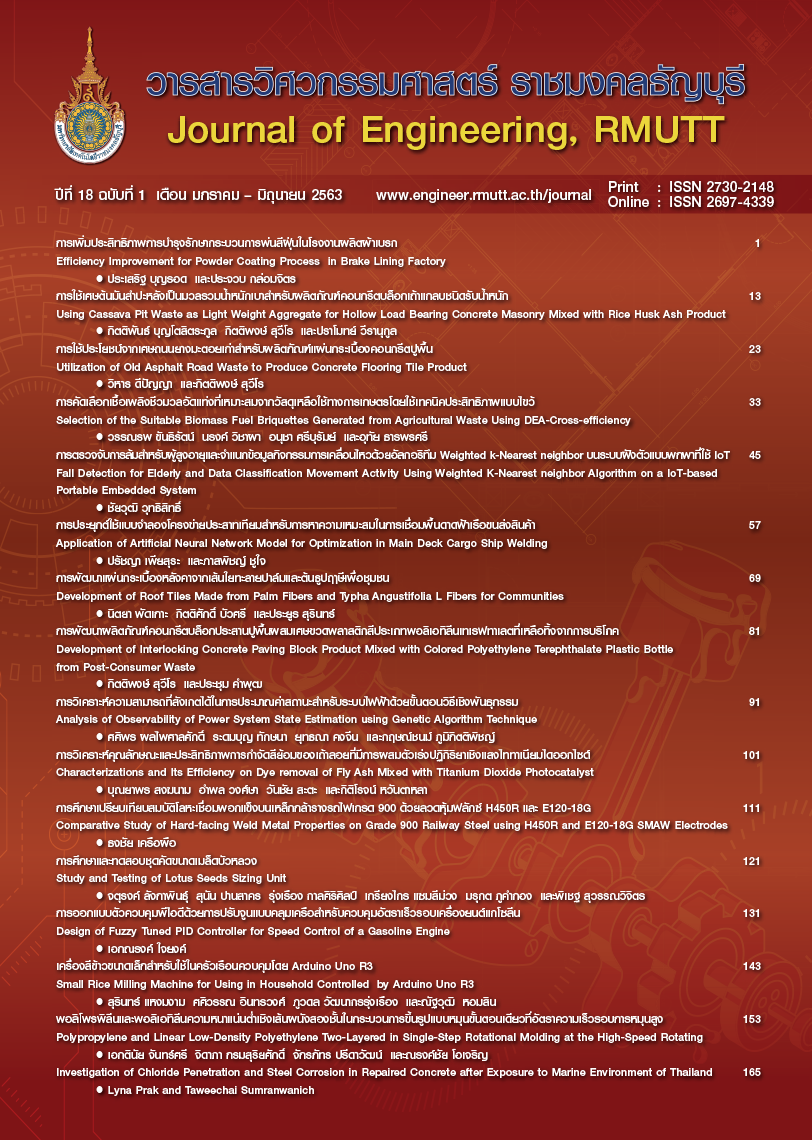การพัฒนาแผ่นกระเบื้องหลังคาจากเส้นใยทะลายปาล์มและต้นธูปฤาษีเพื่อชุมชน
Main Article Content
บทคัดย่อ
การผลิตแผ่นกระเบื้องหลังคาจากเส้นใยทะลายปาล์มและต้นธูปฤาษีเพื่อชุมชน โดยใช้กาวสังเคราะห์ไอโซไซยาเนตเรซิน (pMDI) ปริมาณ 5 เปอร์เซนต์ และ10 เปอร์เซนต์โดยน้ำหนัก ทำหน้าที่เป็นสารยึดติด มีความหนาแน่นของแผ่นกระเบื้องมุงหลังคาที่กำหนด 600 กิโลกรัมต่อตารางเซนติเมตร และขนาดของแผ่น 300X320X15 มิลลิเมตร การทดสอบสมบัติเชิงกายภาพ พบว่า ค่าความหนาแน่น ปริมาณความชื้น การดูดซึม การไม่รั่วซึมน้ำ การพองตัวทางความหนา และสมบัติเชิงกล ค่าความต้านทานมอดูลัสการแตกร้าว ความต้านทานมอดูลัสยืดหยุ่น และความแข็งแรงการกระแทก ที่ใช้กาวสังเคราะห์ไอโซไซยาเนต เรซิน ปริมาณ 10 เปอร์เซนต์โดยน้ำหนัก ให้สมบัติที่ดีกว่า สามารถทดสอบทุกสภาวะอยู่ในเกณฑ์มาตรฐานของ TIS 876-2547, TIS 535–2556, JIS A 5908-2003 และ ASTM D 256-06a และสมบัติเชิงความร้อน ค่าการนำความร้อนและความต้านทานความร้อน ทดสอบตามมาตรฐานของ ASTM C 177-2010 พบว่า การใช้กาวสังเคราะห์ไอโซไซยาเนตเรซิน ที่ปริมาณสารยึดติด 5 เปอร์เซนต์มีค่าการนำความร้อนที่ดีกว่า ส่วนความต้านทานความร้อน กระเบื้องหลังคาจากเส้นใยทะลายปาล์มที่ใช้กาวสังเคราะห์ไอโซไซยาเนตเรซิน ที่ปริมาณสารยึดติด 10 เปอร์เซนต์ มีค่าความต้านทานความร้อนที่ดีกว่า ซึ่งสามารถนำแผ่นกระเบื้องมุงหลังคาจากงานวิจัยไปใช้เป็นวัสดุก่อสร้างและวัสดุทดแทนแผ่นกระเบื้องมุงหลังคาจากซีเมนต์ใยหินได้
Article Details
บทความ ข้อมูล เนื้อหา รูปภาพ ฯลฯ ที่ได้รับการตีพิมพ์ในวารสารแนวหน้าวิจัยนวัตกรรมทางวิศวกรรม ถือเป็นลิขสิทธิ์ของวารสารฯ เท่านั้น ไม่อนุญาติให้บุคคลหรือหน่วยงานใดคัดลอกเนื้อหาทั้งหมดหรือส่วนหนึ่งส่วนใดไปเผยแพร่เพื่อกระทำการใด ๆ ที่ไม่ถูกต้องตามหลักจริยธรรม
References
OonjittichaiW.Wood Substituted.Biocomposites.Forest researchand development bureau.WoodDevelopment division.2012(in Thai)
Center of fuels and energy fromBiomass, Biomass potential inthailand. Departmentof chemical technology [Internet].Chulalongkorn University;2016[cited 2019 Sep 16].available from:http://www.iscisaraburee.sc.chula.ac.th/2017/index.php/2016/06/06/i-sink-under-the-weight-of-the-splendour/
Anantaratanachai S, RampeungJaroenyot. Product of typha paper of automatic machine.department of Industrialengineering. Faculty of engineering and Architecture.Rajamangala University of technology suvarnabhumi. 2013 (in Thai)
Shinoj S, Visvanathan R, Panigraphi,S,Koch Ubabu M.Oil palm fiber (OPF) and itscomposites: A Review. Industrialcrops and product.2011;33:7-22 (in Thai)
Suntijitto A. Influence of cellulose fiber on mechanical andthermal properties offibercement roof sheets in hot-humid climate. Departmentof Architecture. Faculty of Architecture and planning.Thammasat University. 2011 (in Thai)
Padkoh N.Investigationof tileroofsproperties of naturalfibers frompineapple leaffibers andmaize huskfiber.Srinakharinwirot EngineeringJournal.2017; 12 (1):11-9 (in Thai)
Thailand IndustrialStandardsInstitute.Flat pressedparticleboards. TIS. 876-2547. Ministry of Industry.2004:1-17(in Thai)
Thailand Industrial StandardsInstitute.Concrete roof tiles.TIS. 535-2556.Ministry ofIndustry.2013:1-14(in Thai)
Japanese Standards Associationparticleboard,JIS A 5908-2003.Japaneseindustrial standard. Tokyo, HohbunshaCo.Ltd. 2003:23
American Society for testing and materials. ASTM D 256 –06aStandard test methods fordetermining the izodpendulumimpact resistance ofplastics.In 1990Annual book of ASTMStandards.philadelphia ASTM. 2006;8(1):57-73
American Society for testing andmaterials. ,ASTM C 177-10Standard test method forSteady-State heat flux measurementsandthermaltransmission properties bymeans of the ouarded-host-plate apparatus. In annual bookof ASTM Standards,MD,U.S.A. 2010;04(6): 21-32
Jarunjaruphat N,Salinee.Theparticleboardmanufacturingfrom Agricultural wast. TheJournal of KMUTNB.2018;28 (2):469-76 (in Thai)
Thongsri K, Parmotmuang M.The study and developmentof contemporary productdecoration for real woodidentity in thailand.RajamangalaUniversity oftechnology Phra nakhon.Architecture and design.2015 (in Thai)

